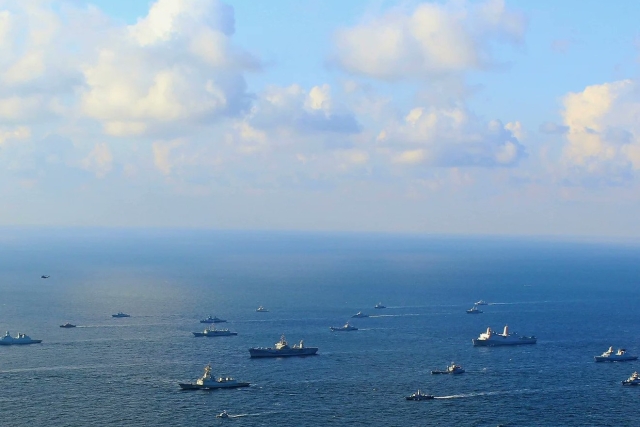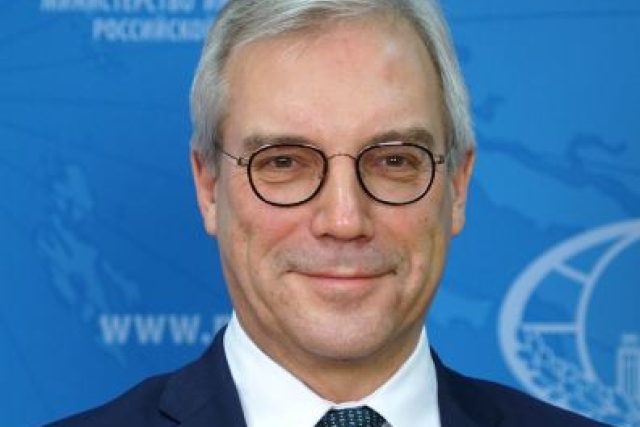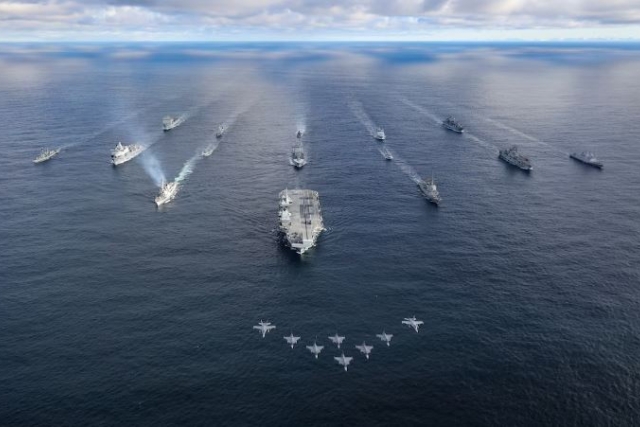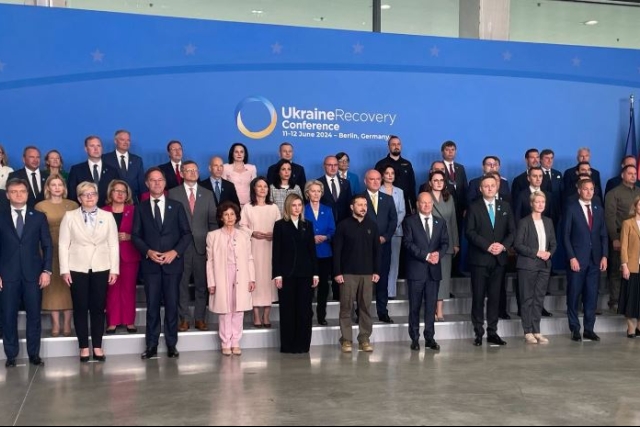NATO’s Intensified Exercises a Prep to Attack Russia?
Russian minister claims NATO is abandoning cooperative security for Cold War-era strategies, preparing for a potential conflict with Russia by reestablishing commands, certifying weapon routes, stationing troops, and streamlining troop movements.

Baltic Operations 2024 (BALTOPS-24) NATO's premier maritime-focused exercise in the Baltic Region
Recent NATO exercises such as the BALTOPS-24, Steadfast Defender 2024 and its first-ever Basic Fighter Maneuvers exercise have been its most intensive ever, leading to Russian allegations that these drills could be a prelude to attack Russia.
NATO began its BALTOPS-24 exercise on June 8, which the U.S. Naval Forces Europe said is "the largest assembled coalition of amphibious and mine countermeasure forces in BALTOPS history."
The exercise involves 20 allies, more than 50 ships, over 85 aircraft, and more than 9,000 personnel. It is taking place under U.S. command, with Germany playing a key role as Commander Task Group.
The exercise includes amphibious landings, underwater mine laying, and even airdrops behind enemy lines to simulate a full-scale assault. As of June 12, NATO has conducted clearance training, amphibious landings, and UUV operations in Latvia, free-fall insertion, field training, and seabed scans in Sweden, and mine countermeasures and air operations in Germany.
Russia anticipates that the exercises could be in preparation for an assault to free Russian-occupied areas of Ukraine, such as the Crimean Peninsula, the Donetsk People's Republic (DPR), and the Luhansk People's Republic (LPR).
NATO preparing for military clash with Russia: Russian Dy Foreign minister
“All that NATO is doing today is preparing the alliance for a possible military clash with Russia. The recent exercises indicate that all concepts of security based on cooperation have been discarded, and NATO has returned to the security schemes of the Cold War,” Deputy Russian Foreign Minister Alexander Grushko stated in an interview with Izvestia on June 13.
Grushko highlighted that NATO has recreated Cold War-era commands, certified routes for weapon and equipment deliveries from Rotterdam and other ports on the Atlantic coast to the eastern flank, stationed military contingents and equipment, and simplified administrative procedures for troop movement.

NATO intensifies exercises
Steadfast Defender 2024
NATO commenced its largest exercise in decades, Steadfast Defender 2024, at the end of January. These exercises, which took place in the Baltic countries, Poland, and Germany until May, aimed to prepare for a conflict with Russia, according to Admiral Rob Bauer, head of NATO’s military committee.
Grushko said the exercise involved 90,000 troops, 32 countries, 80 combat aircraft, 50 warships, and approximately 1,200 armored vehicles. These exercises included a series of interconnected maneuvers involving offensive operations.
Aircraft dogfight exercise
Fighter jets from nine NATO countries participated in Europe’s first-ever basic fighter maneuvers exercise, sometimes called dogfighting, at Ramstein Air Base in Germany, in early June. This exercise is significant in light of the impending transfer of F-16 jets to Ukraine, where they are expected to engage with Russian fighters such as the Su-35 and MiG-29.
“Such an ostentatious demonstration of NATO’s strength is an attempt to exert military pressure on Russia,” Grushko added.
NATO troop deployment
In late February, Belarusian President Alexander Lukashenko claimed that more than 30,000 NATO troops, over 1,000 armored vehicles, about 160 artillery systems and mortars, and 235 aircraft and helicopters had been deployed to the borders of Russia and Belarus.
Military Schengen
In the same month, Germany, the Netherlands, and Poland, along with NATO and the EU, launched a cross-border military corridor to expedite west-to-east troop movements. This initiative designates Germany as the logistical hub, coordinating the PESCO Logistic Hubs project to create a European logistics network. The NATO Support Command JSEC in Ulm will manage the corridor's design and NATO troop movements, aiming for a "Military Schengen" zone for free military movement.

NATO spending $1.25 trillion on defense
Grushko noted the significant resources allocated for these efforts: NATO countries' total military spending exceeds 51% of the global total, a figure between $1.2 and $1.25 trillion, with 20% allocated for weapon purchases according to NATO standards.
“Finally, the alliance has unleashed a hybrid war against the Russian Federation. In the economic sphere, thousands of illegal sanctions have been introduced against our country, and in the ideological sphere, Russia has been demonized. One glaring example is the claim that if NATO is defeated in Ukraine, Russia will invade Poland and the Baltic countries,” Grushko explained.
Abrogation of Russia-West treaties
Grushko pointed out that previous Russia-West treaties, such as the Treaty on Conventional Armed Forces in Europe, the Open Skies Treaty, and the Intermediate-Range Nuclear Forces Treaty, are now defunct due to actions by Washington.
Increase in Ukrainian attacks on Russian air defense systems
There is also a significant increase in Ukrainian attacks on Russian air defense radars in Crimea and other parts of occupied Ukraine in recent weeks.
Ukraine has reportedly struck three Russian surface-to-air defense systems– one S-400 battery and two S-300 batteries - near occupied Chornomorske and Yevpatoria in the intervening night between June 11 and 12.

On June 12, Ukraine said that it had drawn on stocks of antiaircraft missiles recently replenished by allies to shoot down 29 of 30 missiles and exploding drones that Russia had fired at the country in an overnight barrage.
Russian Telegram channels reported on June 13 that in the Crimean operational direction, an E-3F "Sentry" AWACS aircraft crew is performing long-range radar detection and issuing commands to enemy anti-aircraft missile systems. Using the AN/APY-2 radar, they track tactical aircraft up to 500 km away and cruise missiles up to 170 km away. “Electronic reconnaissance with the AN/AYR-1 RTR complex suggests a potential massive missile strike. The Russian Aerospace Forces are preparing their air defense systems to counter this threat,” the reports said.
NATO’s threat of nuclear weapons
Grushko criticized NATO's increasing focus on nuclear weapons in its military strategy, noting discussions about potential deployment in Poland and other countries. He dismissed accusations of Russia’s nuclear threat as attempts to shift blame onto Russia.
West sabotaged Russia-Ukraine Minsk agreements
He spoke of the Minsk agreements “aimed for Donetsk and Lugansk to return to Ukraine with full respect for human rights,” but the West encouraged Kyiv to sabotage these agreements and pushed for a military solution. He argued that the West's support for Ukraine is strategic rather than genuine concern for the country, pointing to the €147 billion allocated by EU countries for military support.
West using Russian assets to finance Ukraine war
G7 leaders are meeting in Italy on June 13 to discuss unlocking $50 billion from frozen Russian assets for Ukraine's war effort. Most of this amount would be a U.S.-backed loan. The EU will provide €1.5 billion next month, 90% for defense and 10% for reconstruction. NATO is also toughening stance against Russian spies, per Chief Jens Stoltenberg.









